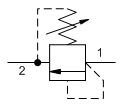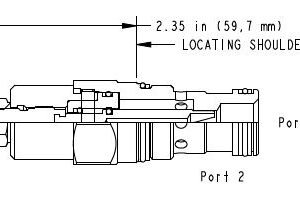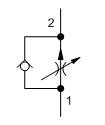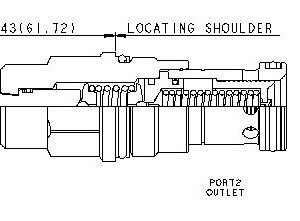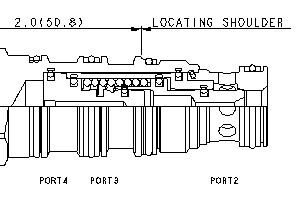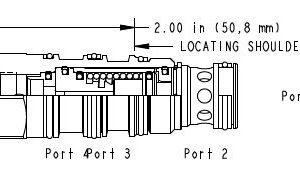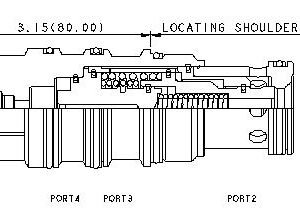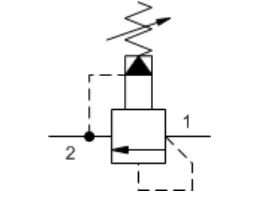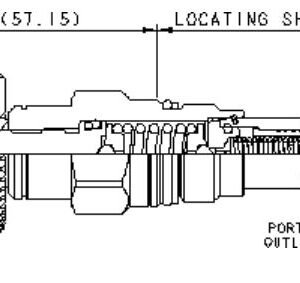care@electrohydraulicscontrols.com
Login / Register
Login
Register
SUN HYDRAULICS Fully adjustable needle valve – pilot capacity(RBAALCN)
£355.20
Direct-acting, pilot relief cartridges are used to remotely control the pressure setting of other pilot-operated valves. Because capacity is limited to pilot flow, these valves should be used with other higher flow valves.
- Main stage orifice is protected by a 150-micron stainless steel screen.
- Suitable for use in load holding applications.
- Back pressure on the tank port (port 2) is directly additive to the valve setting at a 1:1 ratio.
- Cartridges configured with EPDM seals are for use in systems with phosphate ester fluids. Exposure to petroleum based fluids, greases and lubricants will damage the seals.
- W and Y controls (where applicable) can be specified with or without a special setting. When no special setting is specified, the valve is adjustable throughout its full range using the W or Y control. When a special setting is specified, this setting represents the maximum setting of the valve.
SUN HYDRAULICS Fully adjustable needle valve (NFBC-KCN)
Needle valves are fully adjustable orifices used to regulate flow. They are infinitely adjustable from fully closed up to the maximum orifice diameter. They are not pressure compensated and may be used as flow controls or as shutoff valves.
- All 2-port flow control cartridges are physically and functionally interchangeable (i.e. same flow path, same cavity for a given frame size). However, cartridge extension dimensions from the mounting surface may vary.
- Because needle valves are non-compensating devices, the fixed orifice size will regulate flow through the valve in proportion to the square root of the pressure differential across ports 1 and 2.
- A balanced adjustment mechanism allows for easy adjustment even at high pressures.
- The sharp-edged orifice design minimizes flow variations due to viscosity changes.
- The flow path through this valve is bi-directional. The preferred path is port 1 to 2, to allow interchangeability with other flow controls.
- There is no leakage when the adjustment mechanism is turned to the shut-off position.
- Cartridges configured with EPDM seals are for use in systems with phosphate ester fluids. Exposure to petroleum based fluids, greases and lubricants will damage the seals.
- Incorporates the Sun floating style construction to minimize the possibility of internal parts binding due to excessive installation torque and/or cavity/cartridge machining variations.
SUN HYDRAULICS Fully adjustable needle valve (NFDCLAN)
£177.60
Needle valves are fully adjustable orifices used to regulate flow. They are infinitely adjustable from fully closed up to the maximum orifice diameter. They are not pressure compensated and may be used as flow controls or as shutoff valves.
- All 2-port flow control cartridges are physically and functionally interchangeable (i.e. same flow path, same cavity for a given frame size). However, cartridge extension dimensions from the mounting surface may vary.
- Because needle valves are non-compensating devices, the fixed orifice size will regulate flow through the valve in proportion to the square root of the pressure differential across ports 1 and 2.
- A balanced adjustment mechanism allows for easy adjustment even at high pressures.
- The sharp-edged orifice design minimizes flow variations due to viscosity changes.
SUN HYDRAULICS Fully adjustable needle valve with reverse flow check (NCCBLAN)
£163.20
Needle valves with reverse-flow check are fully adjustable orifices used to regulate flow. They are infinitely adjustable from fully closed up to the maximum orifice diameter. An integral high-capacity check valve provides unrestricted flow from port 2 to port 1. They are not pressure compensated.
- All 2-port flow control cartridges are physically and functionally interchangeable (i.e. same flow path, same cavity for a given frame size). However, cartridge extension dimensions from the mounting surface may vary.
- Because needle valves are non-compensating devices, the fixed orifice size will regulate flow through the valve in proportion to the square root of the pressure differential across ports 1 and 2.
- The sharp-edged orifice design minimizes flow variations due to viscosity changes.
SUN HYDRAULICS Fully adjustable needle valve with reverse flow check (NCFCLCN)
£439.20
Needle valves with reverse-flow check are fully adjustable orifices used to regulate flow. They are infinitely adjustable from fully closed up to the maximum orifice diameter. An integral high-capacity check valve provides unrestricted flow from port 2 to port 1. They are not pressure compensated.
- All 2-port flow control cartridges are physically and functionally interchangeable (i.e. same flow path, same cavity for a given frame size). However, cartridge extension dimensions from the mounting surface may vary.
- Because needle valves are non-compensating devices, the fixed orifice size will regulate flow through the valve in proportion to the square root of the pressure differential across ports 1 and 2.
- A balanced adjustment mechanism allows for easy adjustment even at high pressures.
- The sharp-edged orifice design minimizes flow variations due to viscosity changes.
SUN HYDRAULICS Fully adjustable pressure compensated flow control valve with reverse flow check (FDCBHAN)
£518.40
Fully adjustable, pressure-compensated flow controls with reverse-flow check provide precise flow regulation for meter-in or meter-out applications where there may be wide pressure fluctuations. They are infinitely adjustable from nearly closed up to the maximum flow. An integral high-capacity check valve provides unrestricted flow from port 2 to port 1.
- All 2-port flow control cartridges are physically and functionally interchangeable (i.e. same flow path, same cavity for a given frame size). However, cartridge extension dimensions from the mounting surface may vary.
- A balanced adjustment mechanism allows for easy adjustment even at high pressures.
- The sharp-edged orifice design minimizes flow variations due to viscosity changes.
- Minimum leakage is .2 gpm (0,8 L/min) when the adjustment mechanism is turned to the shut-off position.
SUN HYDRAULICS Kick-down, pilot-operated, balanced piston relief valve (RQIBLAN)
£777.60
Kick-down relief cartridges act similar to a circuit breaker in an electrical system. The valves will kick completely open and remain open once the pressure at the inlet (port 1) exceeds the valve settting, creating an unrestricted flow path from port 1 to tank (port 2). The valve remains open as long as the pressure at port 1 exceeds the pressure at port 2. To reset the valve, flow from port 1 to port 2 must cease and pressure at port 2 must be equal to or greater than the pressure at port 1.
- All 2-port relief cartridges (except pilot reliefs) are physically and functionally interchangeable (same flow path, same cavity for a given frame size).
- To reset valve, flow through the cartridge must cease.
- Main stage orifice is protected by a 150-micron stainless steel screen.
- Not suitable for use in load holding applications.
SUN HYDRAULICS Normally closed, balanced poppet, logic element – pilot-to-open(DKFSXHN)
£604.80
This is a normally closed, balanced poppet, switching element. Pilot pressure at port 3 shifts the valve to the open position.
- Unique balanced construction provides predictable switching with 5000 psi (350 bar) at both ports 1 and 2, with the external drain open and a minimum pilot pressure of 300 psi (20 bar).
- Port 1 and port 2 are fully sealed from port 3 and port 4. Ports 3 and 4 are positively sealed.
- Any backpressure at the drain port is directly additive to the required pilot pressure for reliable operation.
- Leakage rate between port 1 and port 2 is very low, typically less than 10 drops/min. at 5000 psi (0,7 cc/min at 350 bar).
SUN HYDRAULICS Normally closed, balanced poppet, logic element with integral T-8A control cavity – vent-to-open (DKFR8HN)
£626.40
This is a normally closed, balanced poppet, switching element with an integral T-8A control cavity. With a 2-way valve in the closed position installed in the T-8A control cavity, the poppet remains closed. Opening the 2-way valve shifts the poppet to the open position, provided there is sufficient pressure at port 3.
- Unique balanced construction provides predictable switching with 5000 psi (350 bar) at port 1 and port 2. Switching will only occur when both a minimum pilot pressure of 400 psi (30 bar) is present and pilot control valve is open.
- These valves are hydraulically balanced between port 1 and port 2.
- Port 1 and port 2 are fully sealed from port 3 and port 4. Ports 3 and 4 are positively sealed.
- Any backpressure at the drain port is directly additive to the required pilot pressure for reliable operation.
- Leakage rate between port 1 and port 2 is very low, typically less than 10 drops/min. at 5000 psi (0,7 cc/min at 350 bar).
SUN HYDRAULICS Normally closed, balanced poppet, logic element with integral T-8A control cavity – vent-to-open (DKJR8HN)
£1,850.40
This is a normally closed, balanced poppet, switching element with an integral T-8A control cavity. With a 2-way valve in the closed position installed in the T-8A control cavity, the poppet remains closed. Opening the 2-way valve shifts the poppet to the open position, provided there is sufficient pressure at port 3.
- Unique balanced construction provides predictable switching with 5000 psi (350 bar) at port 1 and port 2. Switching will only occur when both a minimum pilot pressure of 400 psi (30 bar) is present and pilot control valve is open.
- These valves are hydraulically balanced between port 1 and port 2.
- Port 1 and port 2 are fully sealed from port 3 and port 4. Ports 3 and 4 are positively sealed.
- Any backpressure at the drain port is directly additive to the required pilot pressure for reliable operation.
- Leakage rate between port 1 and port 2 is very low, typically less than 10 drops/min. at 5000 psi (0,7 cc/min at 350 bar).
- Valve will reseat when the pilot pressure falls below 145 psi (10 bar).
SUN HYDRAULICS Pilot-operated, balanced piston relief valve (RPEC-KCN)
Pilot-operated, balanced-piston relief cartridges are normally closed pressure regulating valves. When the pressure at the inlet (port 1) reaches the valve setting, the valve starts to open to tank (port 2), throttling flow to regulate the pressure. These valves are accurate, have low pressure rise vs. flow, they are smooth and quiet, and are moderately fast.
- All 2-port relief cartridges (except pilot reliefs) are physically and functionally interchangeable (same flow path, same cavity for a given frame size).
- Will accept maximum pressure at port 2; suitable for use in cross port relief circuits. If used in cross port relief circuits, consider spool leakage.
- Main stage orifice is protected by a 150-micron stainless steel screen.
- Not suitable for use in load holding applications due to spool leakage.
- Back pressure on the tank port (port 2) is directly additive to the valve setting at a 1:1 ratio.
- Cartridges configured with EPDM seals are for use in systems with phosphate ester fluids. Exposure to petroleum based fluids, greases and lubricants will damage the seals.
- W and Y controls (where applicable) can be specified with or without a special setting. When no special setting is specified, the valve is adjustable throughout its full range using the W or Y control. When a special setting is specified, this setting represents the maximum setting of the valve.
- Corrosion resistant cartridge valves are intended for use in corrosive environments and are identified by the model code suffix /AP for external stainless steel components, or /LH for external zinc-nickel plated components. See the CONFIGURATION section for all options. For further details, please see the Materials of Construction page located under TECH RESOURCES.
- Incorporates the Sun floating style construction to minimize the possibility of internal parts binding due to excessive installation torque and/or cavity/cartridge machining variations.
SUN HYDRAULICS Pilot-operated, balanced piston relief valve (RPEC-LAN)
Pilot-operated, balanced-piston relief cartridges are normally closed pressure regulating valves. When the pressure at the inlet (port 1) reaches the valve setting, the valve starts to open to tank (port 2), throttling flow to regulate the pressure. These valves are accurate, have low pressure rise vs. flow, they are smooth and quiet, and are moderately fast.
- All 2-port relief cartridges (except pilot reliefs) are physically and functionally interchangeable (same flow path, same cavity for a given frame size).
- Will accept maximum pressure at port 2; suitable for use in cross port relief circuits. If used in cross port relief circuits, consider spool leakage.
- Main stage orifice is protected by a 150-micron stainless steel screen.
- Not suitable for use in load holding applications due to spool leakage.
- Back pressure on the tank port (port 2) is directly additive to the valve setting at a 1:1 ratio.
- Cartridges configured with EPDM seals are for use in systems with phosphate ester fluids. Exposure to petroleum based fluids, greases and lubricants will damage the seals.
- W and Y controls (where applicable) can be specified with or without a special setting. When no special setting is specified, the valve is adjustable throughout its full range using the W or Y control. When a special setting is specified, this setting represents the maximum setting of the valve.
- Corrosion resistant cartridge valves are intended for use in corrosive environments and are identified by the model code suffix /AP for external stainless steel components, or /LH for external zinc-nickel plated components. See the CONFIGURATION section for all options. For further details, please see the Materials of Construction page located under TECH RESOURCES.
- Incorporates the Sun floating style construction to minimize the possibility of internal parts binding due to excessive installation torque and/or cavity/cartridge machining variations.
Product categories
- Accessories
- Chrome Rods
- Honed Tubes
- Hydraulic Accumulator
- Hydraulic Cylinders
- Hydraulic Filters
- Hydraulic Manifold Blocks
- Hydraulic Motors
- Hydraulic Power Units
- Hydraulic Pumps
- Hydraulic Seals
- Hydraulic Solutions
- Hydraulic Valves
- Lubrication
- Mobile Controls
- Onsite and Offsite Training
- Tractor Accessories
- Tractor Pump

